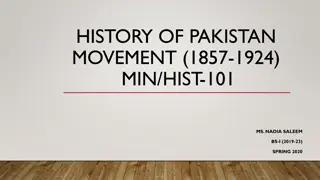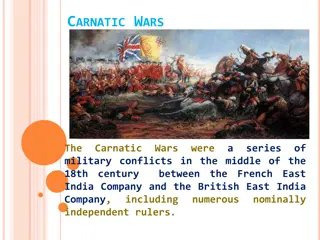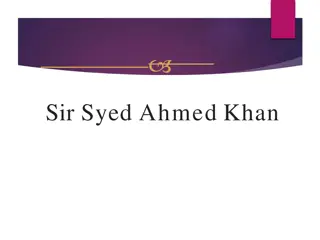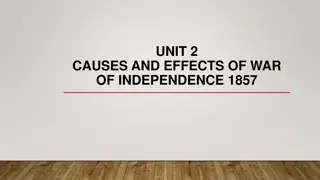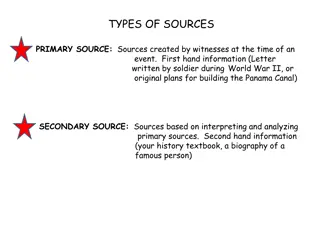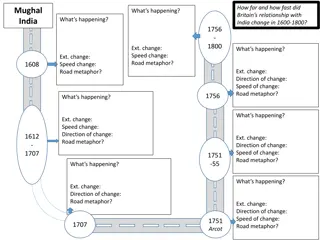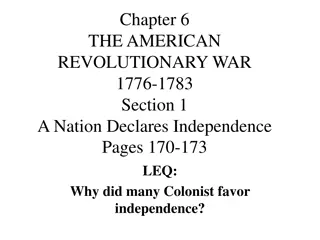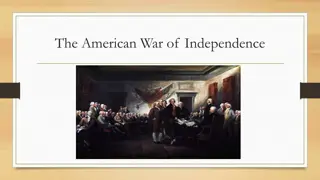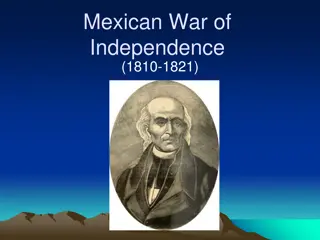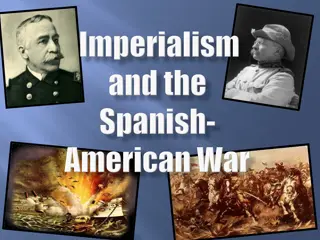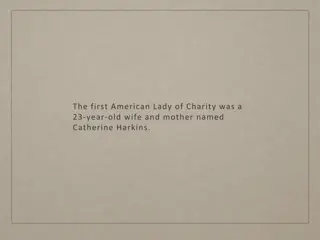Overview of the First War of Independence in India (1757-1857)
The content provides glimpses of India's past, focusing on the period from 1757 to 1857, leading up to the First War of Independence. It outlines the British East India Company's expansion, social issues in Indian society, British oppression, the role of key figures like Ram Mohan Roy, and the eventual revolt in 1857. The narrative also highlights the sacrifices of Indian martyrs and the Company's conquests during this transformative era.
Download Presentation

Please find below an Image/Link to download the presentation.
The content on the website is provided AS IS for your information and personal use only. It may not be sold, licensed, or shared on other websites without obtaining consent from the author. Download presentation by click this link. If you encounter any issues during the download, it is possible that the publisher has removed the file from their server.
E N D
Presentation Transcript
Glimpses of the Past Module 1 From Our Freedom Movement S D SAWANT
Before you read This lesson is an expeditious journey of our country from 1757 to 1857. It is represented through pictures and speech bubbles to clarify our understanding of the conditions that led to the event known as the First War of Independence in 1857.
Synopsis During 18th century, British east India Company was extending its power worldwide. That time Indian princes were fighting each other. East India Company subdued Indian princes one by one. During the period of 1765 to 1836 India had to witness many incidents. Untouchability, child marriage and other social evils existed in Indian society. The people were superstitious also. The British imposed heavy taxes on farmers so that farmers had to abandon their fields. The east India Company s law began to cripple Indian industries. Ram Mohan Roy, a learned person from Bengal understood what was wrong with his country. He was attracted by science and modern knowledge. He went to England and fought for the justice of India. But the British continued to oppress Indians. In 1818 they had passed regulation III, under it, an Indian could be jailed without trial in a court. During 1835-56 Thomas Macaulay suggested a change in Indian Education. They taught Indians their language. By 1856, British had conquered the whole India. Some Indian soldiers in east India Company were ill pleased, discontent was brewing in East India Company s army too. A soldier named Mangal Pandey attacked the adjutant of his regiment and was executed. In 1857, a violent revolt outbroke. The rebellion spread wider. Many landlords lost their lands, because of the British policies . Many rulers like Begum Hazrat Mahal of Lucknow were bitter. Popular leaders like Maulvi Ahmedulla of Faizabaad, Tantya Tope aroused the people of India to fight against British Raj.
The Martyrs The Martyrs Oh my country men! Let your eyes fill with tears, as you recall the sacrifices of India s martyrs.
1. The Martyrs The chapter begins with a tribute paid by Lata Mangeshkar to the martyrs at a function in Delhi.
TheCompanysConquests During 18th century, British east India Company was extending its power in worldwide. That time Indian princes were fighting each other. East India Company subduded Indian princes one by one.
2. The Companys conquests(1757-1849) In India of 1757, the East India Company was in a strong position. They had superior weapons. Indian princes were short-sighted in their approach to the events of the time. Indian princes were fighting with each other , often sought the help of the Company to defeat other princes. Thus these rivalries among Indian princes helped the East India Company and it could easily subdue Indian princes However, the clairvoyant Tipu Sultan of Mysore fought the British till he died fighting. one by one. There were some kings who thanked British for ushering in an era of peace. Others bemoaned that people were becoming slaves of foreigners. gradually
3. British Rule ( 1765-1836) Religious leaders preached ideas like untouchability and child marriage. Indians lost their self respect. The British scorned them. The British wanted profits. Heavy taxes ruined the farmers. The British policies ruined the expert artisans business. The imports from England became tax- free. Inevitably, followed. Between 1822 and 1836 fifteen lakh Indians died of starvation. quick and their famines
GLOSSARY 1. Glimpse : noun a momentary or partial view. 2. Martyrs : plural noun a person who is killed because of their beliefs. 3. Scorned : verb : past tense feel or express contempt 4. Short sighted : adjective lacking imagination or foresight. 5. Subdue : verb conquer / overpower 6. Thug : noun a violent person / a bandit / a robber
Exercise for Practice (I) 1. Look at the first picture and identify the singer. Who else do you see in the second picture?
2. What do you understand by the Company s superiorweapons ? 3. Who is an artisan? Why do you think the artisans suffered? 4. How did the East India Company subdue the Indian princes?
Multiple Choice Questions 1. Lata Mangeshkar singing a song oh my countrymen at a function in Delhi. The occasion must be (i). The dawn of India s Independence where the martyrs and their sacrifices are remembered (ii). The atrocities of British against the animals (iii). None of the options 2. The word superiorweapons means (i). All their wits, rules , regulations and using of advanced form of arms and ammunition. (ii). All their intelligence (iii). All their might and valour
3. The East India Company could easily subdue Indian princes because (i). There were constant rivalries between the Indian princes (ii). Indian princes were short sighted. (iii). Both (i) and (ii) 4. ________ of Mysore fought the British till he died fighting (i). Tipu Sultan (ii). Kunwar Singh (iii). Peshwa Baji Rao
5. Between 1822 and1836 famines ruined the lives of indian farmers and artisans. About ______Indians died of starvation. (i). Fifteen lakh (ii). Hundred (iii). Thousand 6. British were merchants and wanted quick _____ (i). Justice for the Indian farmers (ii). Relaxation in policies associated with regulation III (iii). Profits through their iniquitous policies





